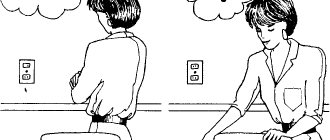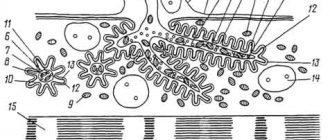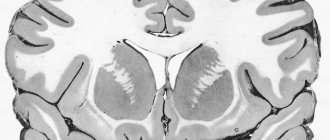Main symptoms:
- Supplementing the perception of phenomena and symbols with certain qualities
Synesthesia is a neurological phenomenon in which the perception of phenomena and symbols is supplemented by certain qualities, for example, sound, color, smell and others. People who exhibit this are called synesthetes. In other words, the phenomenon can be explained as follows: the perception of what is happening, in which one of the sense organs is affected, in parallel with its sensations causes others, which are inherent in a completely different sense organ. In this way, the brain complements our real perception.
Online consultation on the disease “Synesthesia”.
Ask a question to the specialists for free: Neurologist.
- Etiology
- Classification
- Diagnostics
It should be noted that synesthesia is not classified as a mental disorder. This is a kind of adaptation to the surrounding world. But it must be said that the term “synesthesia” is not an entirely accurate definition of this phenomenon: “ideasthesia” is more accurate.
There are different types of synesthesia, and the most common of them is grapheme-color synesthesia. This means that a person perceives letters and numbers differently: for him they are painted in certain colors. Spatial synesthesia is when numbers, years and months are located in space at a specific location.
To date, only some types of the phenomenon have been described by scientists.
Some scientists believe that synesthesia helps people in creative professions. Psychologists and neurologists also study this phenomenon because it is very interesting. In addition, the data will help to understand the process of cognition itself, as well as the perception of all people, not just synesthetes.
Definition of the concept
What is synesthesia? Synesthesia in psychology is a feature of human perception, which is expressed in the unusual experience of different categories of phenomena, such as names, names, sounds. These groups in the subjective world of man acquire additional qualities. For example, an individual “sees” what color a particular month is painted in, tastes the notes, or hears how the colors sound.
A characteristic feature of synesthesia is that such sensations are not true, they do not pass through the corresponding sense organs, but arise only as a reaction.
How can synesthesia be used to benefit humans? Its benefit most often lies in the fact that it becomes easier for a person to navigate information, structure and remember it.
How does synesthesia affect the human psyche? In most cases, a person does not know for a long time that his perception differs from the perception of others. When this becomes clear, he can either continue to ignore it or begin to consider himself special. In any case, thanks to synesthesia, he perceives the world differently, is more sensitive, and often very creative.
Links
- Córdoba MJ de, Hubbard EM, Riccò D., Day SA, III Congreso Internacional de Sinestesia, Ciencia y Arte, 26-29 Abril, Parque de las Ciencias de Granada, Ediciones Fundación Internacional Artecittà, Edición Digital interactiva, Imprenta del Carmen. Granada 2009. ISBN 978-84-613-0289-5
- Córdoba M. J. de, Riccò D. (et al.), Sinestesia. Los fundamentos teóricos, artísticos y científicos, Ediciones Fundación Internacional Artecittà, Granada 2012. ISBN 978-84-939054-1-5
- Cytowic, R.E., Synesthesia: A Union of The Senses, second edition, MIT Press, Cambridge, 2002. ISBN 978-0-262-03296-4
- Cytowic, R.E., The Man Who Tasted Shapes, Cambridge, MIT Press, Massachusetts, 2003. ISBN 0-262-53255-7. OCLC 53186027
- Marks LE, The Unity of the Senses. Interrelations among the modalities, Academic Press, New York, 1978.
- Riccò D., Sinestesie per il design. Le interazioni sensoriali nell»epoca dei multimedia, Etas, Milano, 1999. ISBN 88-453-0941-X
- Riccò D., Sentire il design. Sinestesie nel progetto di comunicazione, Carocci, Roma, 2008. ISBN 978-88-430-4698-0
- Tornitore T., Storia delle sinestesie. Le origini dell'audizione colorata, Genova, 1986.
- Tornitore T., Scambi di sensi. Preistoria delle sinestesie, Centro Scientifico Torinese, Torino, 1988.
- Site of an online community of synesthetes: news and science about synesthesia, synesthesia in art, research on the connection between voluntary and involuntary synesthesia, anthropology of synesthesia
- What is synesthesia: myths and reality - Published in Leonardo Electronic Almanac, v.7, 1999, N 6
- Psychologist Vladimir Levi on the phenomenon of synesthesia in his project “Life Science in Questions and Answers.”
Types of synesthesia
There are many types of synesthesia. They differ in their manifestations. The characteristic features of different types of synesthesia can be seen in the table:
| View | Characteristic |
| Grapheme-color | It involves superimposing a sense of color perception on individual letters and numbers. That is, a person sees the “color” of signs. Thanks to this, he can remember information faster and better and navigate the written text. |
| Musical and color | With this type of phenomenon, a person has formed a reaction in the form of distinguishing the color of sounds. He develops color associations for different notes, voice timbres and other sounds. Thanks to this feature, a person perfectly remembers musical works and speech information perceived by ear. |
| Kinesthetic-auditory synesthesia | This feature of perception allows a person to “hear” the sound of moving objects, for example: a falling leaf, moving clouds or a flying bird. |
| Spatio-temporal | A person with such a mental feature perceives numerical patterns in the form of points located in a certain way in space. This is how he perceives, for example: days of the week, months and hours. Each of the synesthetes of this type has its own associations with numerical sequences, which are not similar to the spatial forms of the other. |
| Lexical-gustatory (lexical-gastic) synesthesia | With this type of mental peculiarity, taste sensations are superimposed on the perception of words. For example, a person may perceive a certain name or title to taste sweet or sour. |
| Acoustic-tactile | This type involves layering tactile sensations on the perception of sounds. For example, when listening to a melody, a person experiences sensations of stroking or warmth in some parts of the body. |
| Ordinal and linguistic personification | With this type of phenomenon, a person perceives numbers and letters as images of objects, people or animals. For example, the letter “A” appears to him in the form of a Gothic castle, and the number 2 - in the image of a sweet grandmother in a headscarf. |
| Misophonia | This is the imposition of emotions on perceived sounds. Most often, this form is classified as a neurological disorder, and it manifests itself in the association of sounds with emotions, most often negative. |
| Mirror synesthesia | This form of synesthesia also most often goes beyond the neurological norm. It is expressed in the fact that a person, observing how another individual, for example, is beaten or stroked, very clearly feels these manipulations. |
| Auric | This type of synesthesia is expressed in the fact that a person perceives the people around him as “colored” in different colors, which depend on their appearance and the feelings of the synesthete that arise when looking at them. |
How do synesthetes appear?
The appearance of such a unique phenomenon caused a lot of controversy in the scientific community. This is understandable, because not every person decides to separate numbers by color or letters by tactile sensations. In the 19th century, synesthesia was considered a pathology. However, after a series of studies, scientists came to the conclusion that this phenomenon is normal, it just occurs in a small group of people. It was originally believed that only 1% of all people on Earth were synesthetes. Although today this figure has increased. Research by Jamie Ward and Julia Simner has shown that one in 100 people has some form of synesthesia. Although there is evidence that 1 in 25,000 people are true synesthetes. The difficulty lies in separating real and pseudosynesthesia. Scientists are also interested in how the phenomenon of synesthesia appeared. Some attribute it to genetic predisposition. For example, Megan Stephen, a scientist at the University of Oxford, believes that genes play an important role in obtaining synesthesia. However, his research suggests that other factors may also have an impact. Stephen conducted an experiment among synesthetes who had lost their sight. Of the 6 people, three received their feature after blindness. Moreover, the subjects demonstrated excellent types of synesthesia. One projected visual images with sound or olfactory sensations, the other began to endow letters and other objects with a certain color. Simon Baron-Cohen from the University of Cambridge believes that the environment or lifestyle contributes to the emergence of this phenomenon. It is important to distinguish between what is real synesthesia and what is associated with projections and hallucinations.
Evidence of the influence of genes on the occurrence of synesthesia is the son of Vladimir Nabokov, Dmitry. He, like his father or mother, inherited this unique phenomenon. Also among synesthetes there are many writers who covered this phenomenon in their works - Baudelaire, Verlaine, Rimbaud. This also includes Tsvetaeva, Balmont, Pasternak and other Russian authors. Synesthesia of sensations was observed in Rimsky-Korsakov and Scriabin, as well as in the Norwegian singer Ida Maria. This phenomenon is noticed not only among creative individuals. For example, Daniel Tammet, a gifted young man who is capable of performing complex mathematical calculations in his head, is also a synesthete. Tammet knows 11 languages, which once again proves his genius. Synesthesia is also observed in Solomon Shereshevsky, a journalist with a phenomenal memory.
As you already understand, synesthetes are able to better understand the world around them, feel more fully, and experience sensations that ordinary people could not even suspect. The presence of synesthesia allows you to solve creative problems, improve and develop your talent. It’s not for nothing that there are so many creative and talented people among famous synesthetes. If you constantly feel additional qualities in familiar things that are not associated with subconscious associations, if they have been haunting you since childhood, congratulations, you are a real synesthete. But if you believe scientists, and this phenomenon is caused not only by genetic predisposition, then an ordinary person is able to develop it. There are even special exercises that allow you to connect additional senses that stimulate the development of synesthesia. They are not difficult to perform, but you will be able to feel unique emotions.
The simplest way is to evoke associations that are unusual for the subject being studied. For example, give the music color or texture. Try to think not only in the categories in which you are accustomed, but go beyond. Always include additional senses that are not normally used for learning. Color should sound, music should have taste, smells should be tangible. This way you can not only feel something that you have not felt before. The presence of synesthesia leads to the emergence of unique ideas that were previously hidden.
The next exercise will require significant brain work. You must learn to think differently. You need to try to imagine famous people - artists, composers or writers - in a different way. Think about what kind of music Pushkin could write, what kind of paintings would come out of Mozart’s brush. This helps develop associations that are atypical for the brain.
A great way to develop synesthesia is through breathing practices. You can also try eye exercises. The better your sensory organs work, the more senses you are able to feel.
To give visual characteristics to smells, you can practice on strongly smelling objects. Close your eyes and alternately bring cloves or oranges, bread or tobacco, lavender or paints to your nose. Any objects that have a specific smell are suitable for the development of synesthesia. Give them visual or tactile characteristics. Something similar was described in Patrick Suskind's novel "Perfume". There, the smell was not only an olfactory perception, but a color and tactile one. This novel describes in detail all the features of the feelings of synesthetes.
To develop tactile sensations, collect a collection of objects that can be differentiated. Touch them, evoke other associations. A wine book or a description of dishes can help develop your sense of taste. Such works most clearly represent the perception of taste and allow one to train this sense organ.
Finally, to become a synesthete, you need to see beyond the surface. For example, we perceive sound too roughly, without focusing on the shades. Even the silence in the apartment is heterogeneous; it is filled with the maximum number of subtler and unnoticeable sounds. Try to recognize them and hear them.
The phenomenon of synesthesia is not just a feature of perception, it is a new way of looking at the world. Today, more and more people are discovering this phenomenon in themselves. It is likely that synesthesia is rapidly spreading across the planet, transmitted at the genetic level. Either humanity is moving to a new level, actively using all senses for perception. Ask yourself questions more often: what does the sound smell like, what color is Monday, what does the smell of strawberry jam feel like? It is likely that you will be able to discover and cultivate a synesthete within yourself.
If you find an error, please select a piece of text and press Ctrl+Enter
.
Anesthesia (insensibility) is the antonym of the word synesthesia, in which a person receives several sensations when only one analyzer is stimulated. As you know, human sensitivity is determined by five analyzers, each of which is responsible for certain sensations:
- Visual;
- Auditory;
- Olfactory;
- Flavoring;
- Tactile.
The sixth analyzer is scattered throughout the body at the points of attachment of muscle tendons to the skeleton and is called proprioceptive. However, the “sixth sense” does not apply to synesthesia. Propriorceptive sensations are regulated by the vestibular apparatus, while all other analyzers are influenced by the limbic system. It is located in the hippocampus - the so-called “olfactory brain”. This is the very first gyrus in the cortex of the cerebral hemispheres, which are united by the corpus callosum. This is a kind of bridge between the left and right halves of the brain. Manifestations of synesthesia indicate a violation of synchrony between the hemispheres of the brain. Therefore, a synesthetic person, most often, has equal command of his right and left hands. He can be called a hidden left-hander, but it would be more correct to call him a generalist.
Causes
The exact causes of synesthesia are currently not fully understood, and there is no general theory of this phenomenon yet. But there are several models that theoretically describe the process of development of synesthesia.
In 1950-1980 One possibility was that neuronal axons in certain parts of the brain lost their myelin sheath. As a result, these nerve cells randomly exchange electrical impulses, causing phantom sensations of images, colors, smells, and tactile sensations.
According to another theory of the same time, the brain of a person with synesthesia retains certain connections between nerve cells that allow the senses to maintain communication with each other. It is assumed that, thanks to such connections, infants perceive the world as a chaotic collection of different sensations, in which impulses from all senses are merged and mixed.
But these two hypotheses have not found universal support in scientific communities, since they do not fully correspond to modern ideas about the peculiarities of the experiences of synesthetes. The main contradiction lies in the selective nature of synesthetic reactions. For example, a person “sees” images of letters, but does not experience any additional sensations when perceiving other signs. In this case, it becomes unclear whether neurons with a missing myelin layer can be so selective, and whether an infant's brain can maintain connections between neurons if it first needs to learn to recognize music or letters.
Today, the most common concept about the reasons for the formation of grapheme-color synesthesia is the theory of cross-activation. It occurs between two areas of the brain - color and symbol perception, located next to each other. In this case, the part of the brain responsible for colors is subordinated to the area of perception of letters or numbers. According to the theory, synesthesia is a congenital feature associated with gene mutation. The brain of such a person is characterized by increased white matter content and higher metabolic activity in a specific region of the brain.
This concept also has its drawbacks:
- it does not explain the selective nature of synesthetic reactions;
- the phenomenon of synesthesia between sensations for which areas of the brain located far from each other are responsible is not reflected;
- the role of stimuli that cause synesthesia is not taken into account: music, titles, names and other cultural phenomena of society. It is likely that several areas of the brain are responsible for the perception of such complex phenomena, and not just two located nearby.
Alternative view
God is organic. Yes. And the man?
And the person must be limited.
—
© I. A. Brodsky
It has been established that the human brain is able to perceive information about the world around us using six main senses. We see, hear, taste, smell, feel with our skin and can maintain balance by “regulating” the position of the body in space. Our ears do not see, our skin does not smell. However, this does not mean that the senses are completely independent of each other.
Partial replacement
Despite the apparent “autonomy,” the perception of each sense organ is closely interconnected with the others. This allows us to get a more complete picture of the world around us, like a puzzle in which all the details, individually representing a riddle with an incomprehensible result, are in their places.
All the more interesting is the work of the senses in a situation where one of them, for some reason, is not able to provide a full analysis of the environment and the transmission of this information to the brain.
At such moments, the “musketeer mode” turns on, when one for all, and all for one. The functions of the dysfunctional organ are redistributed to the rest, but this does not mean that the blind will begin to see with their ears, and the deaf will begin to hear with their nose. It is well known that the former have better developed tactile sensations and hearing, while the latter perfectly read lips and gesture, having developed motor skills several times better than those of an ordinary person. However, there are exceptions to every rule - for example, synesthesia. Promotional Video:
Alternative Feeling
Traditional excerpt from the dictionary:
Synesthesia (ancient Greek “together”, “sensation”) is a neurological phenomenon in which stimulation in one sensory or cognitive system leads to an automatic, involuntary response in another sensory system. A person who experiences such an experience is a synesthete.
Another definition of synesthesia is a phenomenon of perception in which stimulation of one sense organ, along with sensations specific to it, also causes sensations corresponding to another sense organ.
Synesthesia is not a mental disorder.
It does not apply to any pathologies, quite the opposite - it greatly helps a person who, by the will of fate, has lost one of his senses. This is an incredibly interesting phenomenon, but its study has been abandoned - there are too few who have developed synesthesia and who have been lured into research labyrinths. It is believed to be present in every person and is most pronounced in infants. In adults, too, but at about six months of age, complete “separation” of the senses already occurs, and catching these sensations becomes problematic. Some researchers have dubbed this process the death of neurons responsible for the preservation of synesthetic connections. Those with synesthesia still have these neurons.
They arise associatively. A simple example is color perception. In many countries, the “official” mourning color is black, and therefore the average European involuntarily perceives it as something gloomy and depressing. And in the East, the color white is perceived in exactly the same way - it is precisely this color that is associated there with the mourning atmosphere.
If synesthesia is not very pronounced, then this contributes to better memorization of information: the associative impression is “duplicated” on several sensory organs at once. Here it would be appropriate to cite an anecdotal situation with a man who decided to remember the number of his carriage in an unusual way: “1492, the year of the discovery of America... I definitely won’t forget!”, and then ran around the station and asked passers-by if they knew when America was discovered .
Another thing is congenital synesthesia. First, an association arises, a primary synesthetic image, and only then a general impression received through the main senses. Solomon Shereshevsky, a professional mnemonist, possessed this ability.
He had a phenomenal ability to memorize series of words, tables of numbers, long meaningless formulas, phrases of an unfamiliar language. In most cases, he could accurately recall the same series of words, formulas, and phrases several years later. The limits of his memory in terms of volume and duration were not traced. Shereshevsky's memory was built primarily on spontaneous synesthetic associations. Words for him were images with the addition of various taste, visual and tactile sensations.
Shereshevsky's synesthesia was so strong that associations sometimes displaced the main feeling. He himself recalled it this way:
I approach the ice cream saleswoman and ask what varieties she has. “There’s plenty of everything!” - she answers in such a tone that a whole heap of coals and ash flies out of her mouth. People's voices are bouquets of flowers, puffs of smoke or fog. I get so carried away by looking at voices that sometimes I can’t understand what they’re talking to me about.
The memory of “ordinary” synesthetes, despite its apparent phenomenal nature, is easily influenced by chaos. If you change the places of familiar objects, it will bring confusion into their mind, so for the most part they are people who are scrupulous about order.
Combination of incongruous
Among the many varieties of synesthesia, chromesthesia, also known as acoustic-color synesthesia, or simply color hearing, stands out. Synaesthetes with this ability, when hearing a sound, as a “bonus”, perceive it not only as an ordinary sound sensation - they also add a color sensation. Modern musicians with colored hearing say that this is a poorly controlled and rather unpleasant phenomenon - there is too much noise around us.
Many have tried to draw the “spectrum-octave” analogy. The history of light music stretches back to about 1650, when the first theories on this matter appeared. They were very popular in the 17th-19th centuries, and were conventionally divided into two options:
- color music - a scale is accompanied by a certain color sequence;
- music of color - the complete absence of music, the replacement of sounds with a spectrum corresponding to the octave.
At first it was believed that each note corresponds to a certain color, but with synesthetes this is not the case - everything is purely individual. But is this a good enough reason not to try to combine the incompatible? An example of this is the “symphony of light” in “Prometheus” by A. N. Scriabin. In his score there is a line “Luce” (“Light”), written in familiar notes for an unusual instrument - a light keyboard, but there is no specific indication of the correspondence of notes and colors. This did not stop Prometheus from being staged with lighting, starting in 1915.
One of the main problems of early light music was that the idea was ahead of technical progress. There is a composition, but there is nothing to perform it on. Of course, there were tests, and quite a few, but still the process of staging a light and music work was often beyond the capabilities of ordinary musicians. Therefore, the next revolution in this direction occurred in the 70s of the last century: it can be characterized in two words, “Equipment to the masses!” This was facilitated by the development and reduction in cost of electronics, its universal distribution, and the use of high-quality lighting equipment at concerts. At the same time, rather primitive, but still performing their direct function, “home” light and music installations appeared, and research was carried out on the impact of color music on astronauts. Another decade later, many schools of color music appeared throughout Europe.
It has been established that any musical effect can be enhanced with the help of color. This principle is applied in discos, and even in cinemas - a film in a modern format is often enhanced not only by color, but also by other influences - vestibular, tactile and olfactory.
Supersense
Color hearing is the most common manifestation of synesthesia, but this does not mean that others do not occur. So, the patient of Dr. Richard Saitovich was a 12-year-old boy who took different poses depending on what word he was told. The child was convinced: each word contains a specific movement, and he simply shows which one. This phenomenon was called audiomotor synesthesia. The doctor repeated the experiment: a few years later he found an already matured patient and, without warning, said a few words to him. The young man repeated the same movements as in childhood - the synesthetic perception remained the same.
Many synesthetes “see” the colors of letters and numbers. An even greater number distinguishes the “color” of sound. Vision and hearing appear more often than other sensory organs in the “case of synaesthetes,” but there is also a tactile-gustatory combination, and a figurative one—looking at an object and feeling what it feels like to the touch.
It is impossible to accurately calculate how many types synesthesia includes. Yes, it is based on the usual organs of perception, but there are many more reactions - a synesthete rarely has only one.
Synesthesia and the world around us
So much in life depends on the question, “Do you see what I see?” This question connects people socially... But when you see something that no one around you sees, you feel something that no one feels, you are doomed to loneliness. The world around you is like a raging ocean, and your inner sensations are a tiny uninhabited island of pale yellow “Rs”, turquoise Tuesdays and wine-colored “A” notes - Patricia Duffy, synesthete.
Attempts to explain the synesthetic perception of the world from the point of view of habitual rationalism and logic only strengthen the wall between the owner of unusual abilities and the world around him. The very existence of synesthesia is direct proof that reality cannot be the same for everyone. But, unfortunately, what the majority is not able to realize is rejected as having no right to life. Society is too obsessed with rationalism and relies only on the six basic senses. Do synesthetes really need them? Maybe for him it’s just a symbol of obtaining information about the world around him, and not his tool?
How to develop synesthesia
Synesthesia of sensations is a phenomenon that is given to a person by nature or is formed independently in the process of development. From the point of view of scientists, it is not possible to influence its formation today. A person can invent additional sensations from the perception of certain stimuli, but this will not be a phenomenon of true synesthesia.
Examples of synesthesia
One of the striking examples of people with synesthesia was the writer V. Nabokov; he saw letters and sounds in color, for example, the letter V seemed to him quartz-pink.
Another well-known example of a synesthete in psychology is the philosopher J. Locke, who layered sounds with colors in his perception; for example, he said that the crimson color reminds him of the sound of a trumpet.












